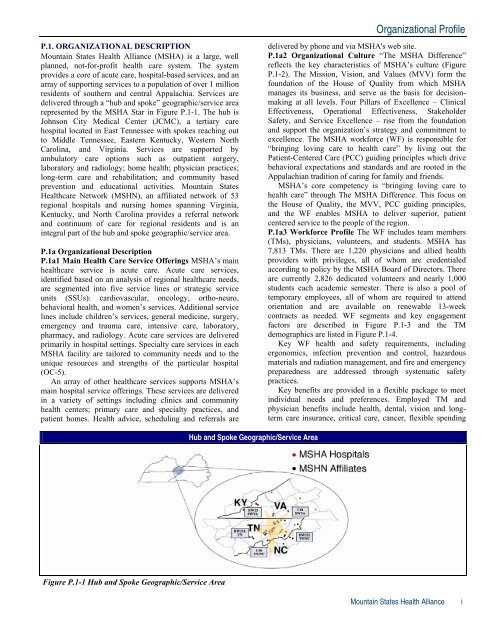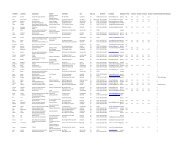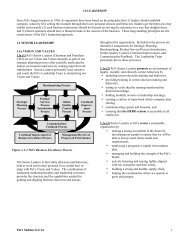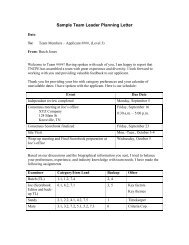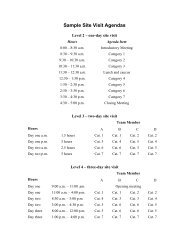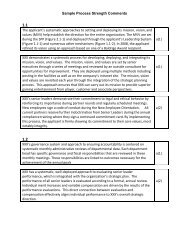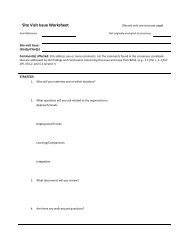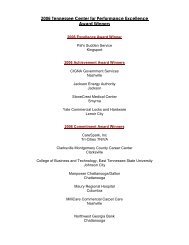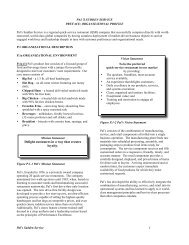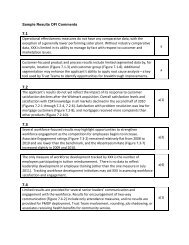Preface: Organization Profile - Tennessee Center for Performance ...
Preface: Organization Profile - Tennessee Center for Performance ...
Preface: Organization Profile - Tennessee Center for Performance ...
You also want an ePaper? Increase the reach of your titles
YUMPU automatically turns print PDFs into web optimized ePapers that Google loves.
P.1. ORGANIZATIONAL DESCRIPTION<br />
Mountain States Health Alliance (MSHA) is a large, well<br />
planned, not-<strong>for</strong>-profit health care system. The system<br />
provides a core of acute care, hospital-based services, and an<br />
array of supporting services to a population of over 1 million<br />
residents of southern and central Appalachia. Services are<br />
delivered through a “hub and spoke” geographic/service area<br />
represented by the MSHA Star in Figure P.1-1. The hub is<br />
Johnson City Medical <strong>Center</strong> (JCMC), a tertiary care<br />
hospital located in East <strong>Tennessee</strong> with spokes reaching out<br />
to Middle <strong>Tennessee</strong>, Eastern Kentucky, Western North<br />
Carolina, and Virginia. Services are supported by<br />
ambulatory care options such as outpatient surgery,<br />
laboratory and radiology; home health; physician practices;<br />
long-term care and rehabilitation; and community based<br />
prevention and educational activities. Mountain States<br />
Healthcare Network (MSHN), an affiliated network of 53<br />
regional hospitals and nursing homes spanning Virginia,<br />
Kentucky, and North Carolina provides a referral network<br />
and continuum of care <strong>for</strong> regional residents and is an<br />
integral part of the hub and spoke geographic/service area.<br />
P.1a <strong>Organization</strong>al Description<br />
P.1a1 Main Health Care Service Offerings MSHA’s main<br />
healthcare service is acute care. Acute care services,<br />
identified based on an analysis of regional healthcare needs,<br />
are segmented into five service lines or strategic service<br />
units (SSUs): cardiovascular, oncology, ortho-neuro,<br />
behavioral health, and women’s services. Additional service<br />
lines include children’s services, general medicine, surgery,<br />
emergency and trauma care, intensive care, laboratory,<br />
pharmacy, and radiology. Acute care services are delivered<br />
primarily in hospital settings. Specialty care services in each<br />
MSHA facility are tailored to community needs and to the<br />
unique resources and strengths of the particular hospital<br />
(OC-5).<br />
An array of other healthcare services supports MSHA’s<br />
main hospital service offerings. These services are delivered<br />
in a variety of settings including clinics and community<br />
health centers; primary care and specialty practices, and<br />
patient homes. Health advice, scheduling and referrals are<br />
<strong>Organization</strong>al <strong>Profile</strong><br />
delivered by phone and via MSHA's web site.<br />
P.1a2 <strong>Organization</strong>al Culture “The MSHA Difference”<br />
reflects the key characteristics of MSHA’s culture (Figure<br />
P.1-2). The Mission, Vision, and Values (MVV) <strong>for</strong>m the<br />
foundation of the House of Quality from which MSHA<br />
manages its business, and serve as the basis <strong>for</strong> decisionmaking<br />
at all levels. Four Pillars of Excellence – Clinical<br />
Effectiveness, Operational Effectiveness, Stakeholder<br />
Safety, and Service Excellence – rise from the foundation<br />
and support the organization’s strategy and commitment to<br />
excellence. The MSHA work<strong>for</strong>ce (WF) is responsible <strong>for</strong><br />
“bringing loving care to health care” by living out the<br />
Patient-<strong>Center</strong>ed Care (PCC) guiding principles which drive<br />
behavioral expectations and standards and are rooted in the<br />
Appalachian tradition of caring <strong>for</strong> family and friends.<br />
MSHA’s core competency is “bringing loving care to<br />
health care” through The MSHA Difference. This focus on<br />
the House of Quality, the MVV, PCC guiding principles,<br />
and the WF enables MSHA to deliver superior, patient<br />
centered service to the people of the region.<br />
P.1a3 Work<strong>for</strong>ce <strong>Profile</strong> The WF includes team members<br />
(TMs), physicians, volunteers, and students. MSHA has<br />
7,813 TMs. There are 1,220 physicians and allied health<br />
providers with privileges, all of whom are credentialed<br />
according to policy by the MSHA Board of Directors. There<br />
are currently 2,826 dedicated volunteers and nearly 1,000<br />
students each academic semester. There is also a pool of<br />
temporary employees, all of whom are required to attend<br />
orientation and are available on renewable 13-week<br />
contracts as needed. WF segments and key engagement<br />
factors are described in Figure P.1-3 and the TM<br />
demographics are listed in Figure P.1-4.<br />
Key WF health and safety requirements, including<br />
ergonomics, infection prevention and control, hazardous<br />
materials and radiation management, and fire and emergency<br />
preparedness are addressed through systematic safety<br />
practices.<br />
Key benefits are provided in a flexible package to meet<br />
individual needs and preferences. Employed TM and<br />
physician benefits include health, dental, vision and longterm<br />
care insurance, critical care, cancer, flexible spending<br />
Hub and Spoke Geographic/Service Area<br />
Figure P.1-1 Hub and Spoke Geographic/Service Area<br />
Mountain States Health Alliance<br />
i


